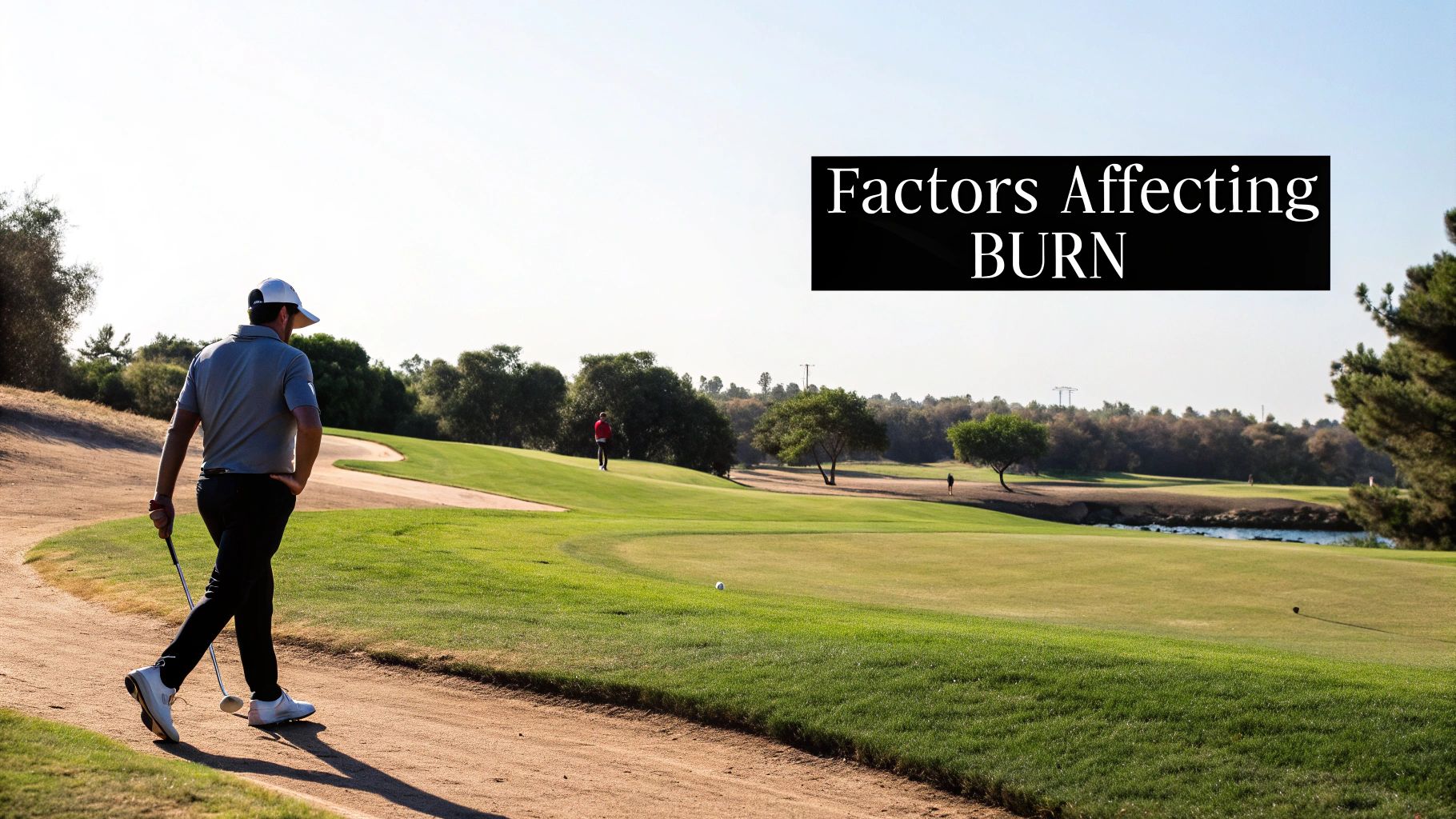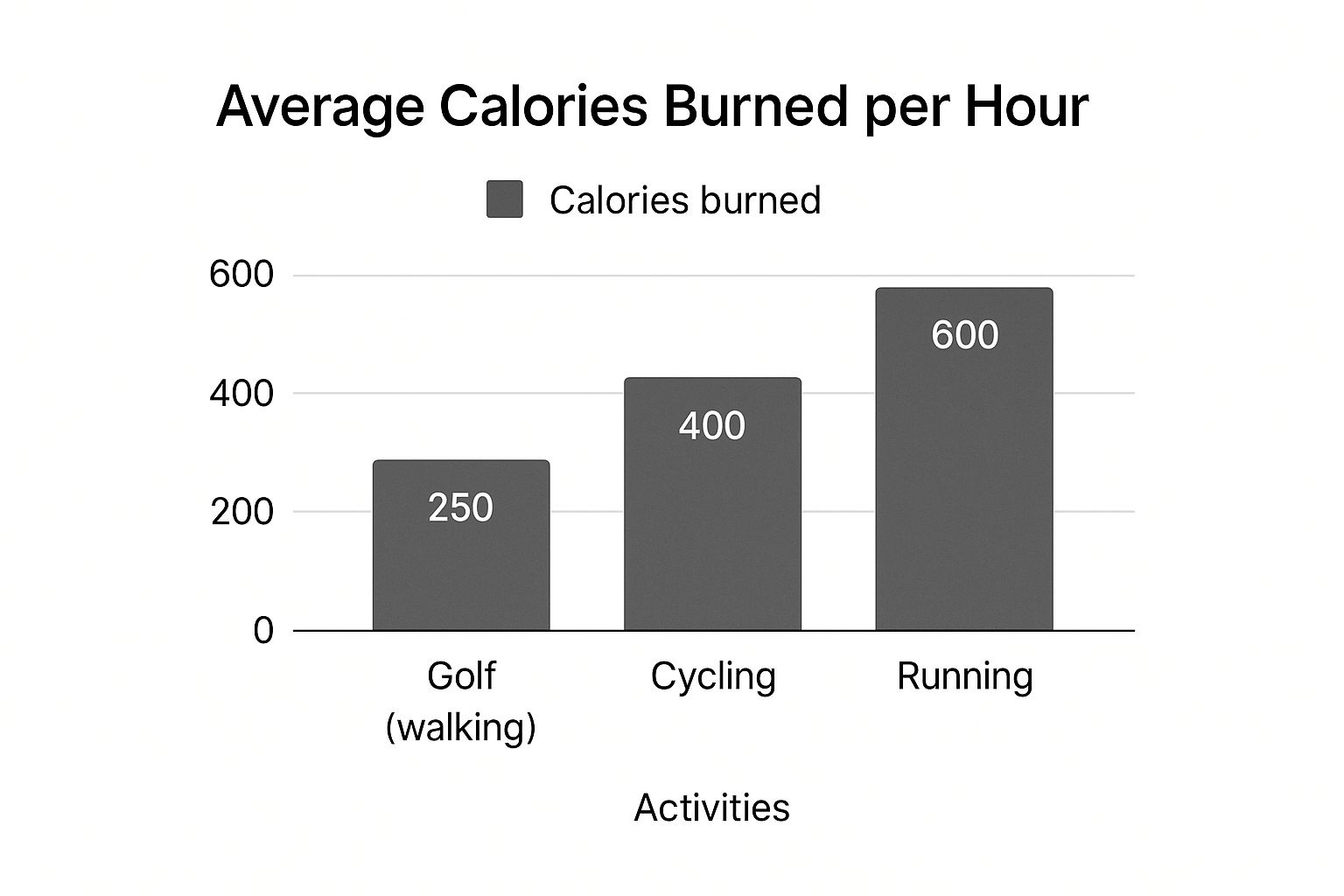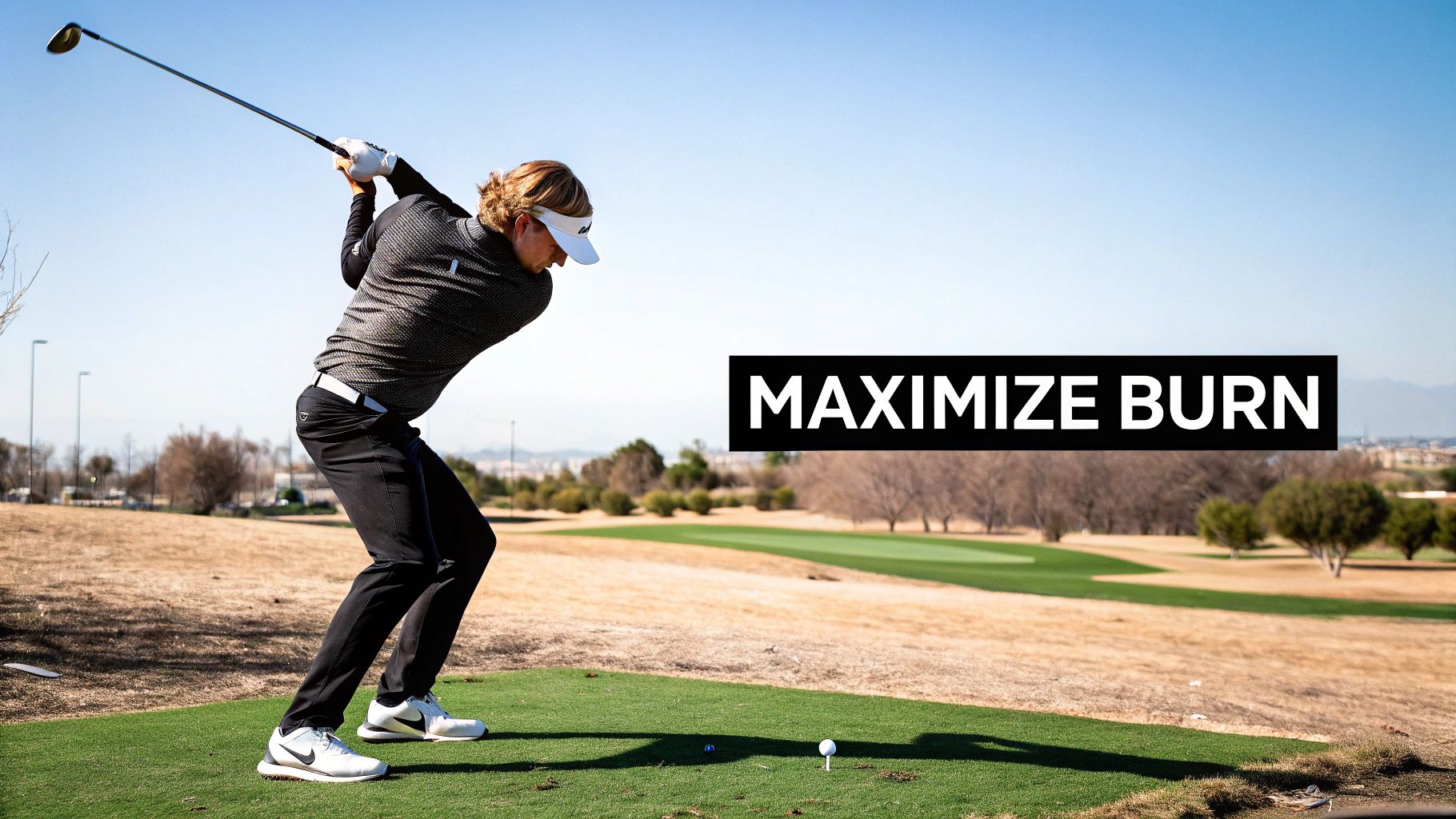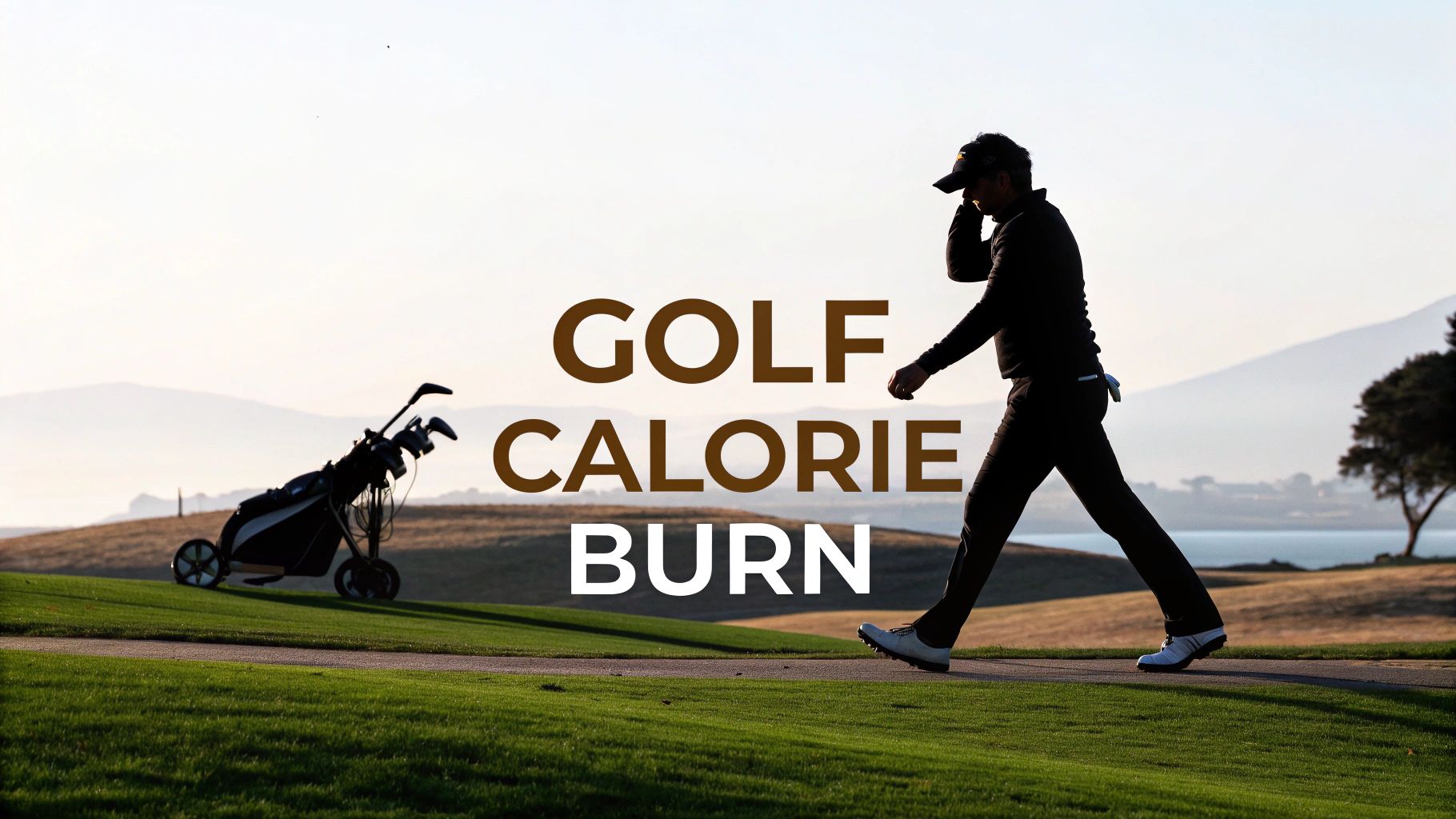Think golf is just a leisurely stroll in the park? Think again. A full 18-hole round is a legitimate workout, and the numbers might surprise you. On average, a player can expect to burn anywhere from 700 to 1,000 calories. That puts a round of golf on par with an intense hour-long run or a high-intensity interval training (HIIT) session.
The Real Calorie Burn of a Round of Golf
Let's bust the myth that golf is a passive sport. When you walk the fairways, you're engaging in some serious moderate-intensity exercise that adds up over 18 holes. It's a fantastic way to stay active and healthy while enjoying your favorite hobby. The key is understanding how your choices on the course directly impact the physical demands of the game.
Of course, the final calorie count isn't one-size-fits-all. Several factors come into play, like the course's terrain and how you get your clubs from one hole to the next. Even your body weight makes a difference; a 180-pound golfer will burn considerably more than a 150-pound player walking the same round. Even a simple practice session at the driving range can burn around 215 calories per hour, proving every part of the game contributes to your fitness.
Walking vs. Riding: The Core Difference
The single most impactful decision you'll make for your calorie burn is whether to walk or take a cart. Walking an 18-hole course can easily cover four to eight miles. This sustained physical effort is what elevates golf from a simple pastime to a genuine workout.
The method of play is the primary driver of calorie expenditure. Walking the course while carrying your clubs can almost double the calories burned compared to riding in a cart, with some studies showing a burn of up to 2,000 calories per round on very hilly courses.
That massive difference shows how much the activity changes when you take walking out of the equation. Sure, riding in a cart still involves swinging and some short walks, but it cuts your total steps and cardiovascular effort by more than half. You can find more details on this topic by exploring how golf impacts your fitness at VesselGolf.com.
To help you visualize how your choices stack up, here’s a quick breakdown of what you can expect to burn during a typical 18-hole round.
Estimated Calorie Burn for an 18-Hole Round of Golf
This table gives you a snapshot of the average calories burned during a round, depending on how you play. It also shows you what kind of traditional exercise that's equivalent to.
| Method of Play | Estimated Calorie Burn (18 Holes) | Equivalent Exercise |
|---|---|---|
| Walking & Carrying Bag | 1,200 - 2,000 Calories | 2-Hour Moderate Hike |
| Walking with Push Cart | 1,000 - 1,500 Calories | 90-Min Vigorous Biking |
| Walking with a Caddie | 900 - 1,200 Calories | 75-Min Jogging |
| Riding in a Golf Cart | 700 - 1,000 Calories | 60-Min Brisk Walk |
As you can see, the numbers speak for themselves. Opting to walk, whether you carry your bag or use a push cart, dramatically increases the physical benefits of your round. So next time you head out, consider leaving the cart behind and turning your game into a great workout.
How You Play Directly Shapes Your Workout

When it comes to the calorie burn playing golf, the single biggest lever you can pull is how you get around the course. Your choices can transform a leisurely stroll into a genuine workout. Imagine two players on the exact same course, shooting the same score—they can end up with completely different fitness results based on one key decision: how they transport their clubs.
This isn't just about walking versus riding. It's a whole spectrum of physical effort where every choice adds up. From carrying your own bag to hiring a caddie, each method tweaks the intensity and, in turn, your total energy burn. Let's break down the real-world impact of these common playing styles.
The Spectrum of Effort: Walking vs. Riding
The most dramatic shift in your workout comes from the simple decision to walk instead of ride in a golf cart. It might be convenient, but hopping in a cart strips away the primary fitness benefit of golf: sustained, low-impact walking over several miles. You’ll still get some activity from swinging and short walks to your ball, but you're leaving a huge chunk of physical conditioning on the table.
Walking a full 18-hole course means covering anywhere from four to eight miles. That continuous movement keeps your heart rate elevated and your muscles engaged for the entire four to five hours of a round. It’s this endurance aspect that turns your golf hobby into a legitimate form of moderate-intensity cardio.
Your approach to the game directly dictates its fitness value. The simple act of walking instead of riding can more than double your physical exertion, turning your hobby into a powerful tool for health and wellness.
This distinction is key for anyone looking to align their golf game with their fitness goals. Choosing to walk is choosing to invest more deeply in the physical side of the sport.
The Impact of How You Carry Your Clubs
Once you’ve committed to walking, the next choice is how you handle your clubs. This decision adds another layer to your workout intensity, directly influencing how many calories you ultimately burn.
-
Carrying Your Bag: This is the most physically demanding option. Think of it as going for a long hike with a 30-pound weighted pack on your back. Every step demands more from your body, engaging your core, back, and leg muscles to stabilize the load. This method maximizes your calorie burn and builds serious functional strength.
-
Using a Push Cart: Pushing your clubs is a fantastic middle ground. You still get the full benefit of walking the course, but you offload the weight from your shoulders and back. This reduces the strain on your spine while still providing a robust cardiovascular workout. The effort is slightly less than carrying, but it's a world away from riding.
-
Hiring a Caddie: Walking the course with a caddie still provides an excellent workout. You cover the same distance on foot, reaping all the cardiovascular rewards. However, since the caddie is doing the heavy lifting, your total energy expenditure will be slightly lower than if you were carrying or even pushing your own clubs.
The Hard Numbers Behind Your Choices
These aren't just abstract ideas—they're backed by solid data. Research from the Rose Center for Health and Sports Sciences gives us a clear picture of how these choices translate into actual calorie expenditure. Over just nine holes, golfers who walked and carried their bags burned an average of 721 calories.
Using a push cart resulted in a nearly identical burn of 718 calories, proving its incredible value as a fitness tool. Walking with a caddie brought the number to a still-impressive 613 calories. And in stark contrast, those who rode in a cart burned only 411 calories for the same nine holes. You can dive into the complete study findings to see how golf benefits your health at ASGCA.org.
These numbers tell a powerful story. The way you play is a direct reflection of the workout you get. By understanding this, you can actively shape your round to meet your personal fitness goals, whether that’s maximizing your burn or simply enjoying a healthy walk in a beautiful setting.
The Hidden Factors That Influence Calorie Burn

While choosing to walk or ride is the biggest fork in the road for your calorie burn playing golf, it's far from the only variable. A whole host of other elements—some obvious, some subtle—come together to determine how much energy you actually use out there.
Think of it this way: your final calorie count isn't some fixed number. It’s a dynamic result that shifts based on your body, the course you're playing, and the unique conditions of your round.
A simple analogy is to think of your body as a car. A larger, heavier vehicle naturally needs more fuel to go the same distance as a smaller, lighter one. The same principle applies to us on the golf course. Your personal body weight is a huge driver of calorie expenditure.
A 200-pound player will burn more energy walking a hole than a 150-pound player, even if they take the exact same number of steps. That’s just physics—their body has to work harder to move more mass against gravity. This difference is a constant from the first tee to the final putt.
The Course Itself Is Your Gym
Not all golf courses are created equal, and their design has a massive impact on your workout. A flat, straightforward parkland course presents a totally different physical challenge than a rugged, hilly links-style layout. The ground beneath your feet is one of the most significant hidden factors influencing your burn rate.
Just think about these course-related variables:
- Elevation Changes: Walking up and down hills forces your leg muscles—glutes, quads, and calves—to work way harder. A hilly course can crank up your calorie burn by 10-20% compared to a completely flat one.
- Rough and Turf Conditions: Slogging through thick rough or walking on soft, damp turf demands more effort than a leisurely stroll down a firm, manicured fairway. Your body has to constantly stabilize itself, firing up smaller muscles and burning more energy with every step.
- Course Layout: Those long walks from the green to the next tee box really add up over 18 holes. A sprawling layout means more steps and a higher total distance covered, which directly boosts your calorie burn.
The course is more than just the playing field; it's an active participant in your workout. A challenging, undulating course acts like a natural resistance machine, amplifying the physical demands of every hole and significantly increasing your overall energy expenditure.
This means that choosing where you play can be just as important as how you play. Simply opting for a hillier course is a fantastic way to get a more vigorous workout without changing anything else. Exploring the many benefits of walking a golf course can give you even more motivation to tackle these tougher layouts.
Your Swing: The Explosive Calorie Burner
Finally, let’s not forget the golf swing itself. It’s not just a casual motion; it's an explosive, full-body athletic movement that adds a surprising amount to your total calorie burn. Every single time you address the ball and let it rip, you're engaging a complex chain of muscles.
From your legs providing a stable base to your core rotating for power and your arms and shoulders delivering the clubhead, the swing is a powerful exercise. Even if you're a scratch golfer who only takes 72 shots, when you factor in dozens of practice swings, you might perform this full-body movement over 100 times in a single round.
This repeated, forceful action keeps your muscles activated and your metabolic rate elevated between the longer periods of walking. It’s a key part of what makes golf a unique form of fitness, blending sustained cardio with repeated bursts of athletic power.
How Your Watch Actually Tracks Your Golf Workout
Ever finish 18 holes, glance at your fitness watch, and wonder how it really knows how many calories you just burned? It’s not pulling numbers out of thin air. It’s a pretty cool mix of biology and technology working in sync to create a detailed picture of your physical effort on the course. To really get it, we need to peek behind the curtain at the science your tracker is using.
The whole system is built around a concept called Metabolic Equivalents, or METs. That might sound like complex jargon, but it’s actually simple. Think of a MET as a single "unit of energy." One MET is the energy you use just sitting still. From there, every other activity is measured as a multiple of that baseline.
For instance, a casual walk might be rated at 3 METs, meaning it takes three times the energy of just resting. Your fitness tracker takes this core idea and layers on your personal data to get a surprisingly accurate estimate of your calorie burn while playing golf.
Building the Full Picture on Your Wrist
A modern fitness watch is loaded with tiny sensors that act like little detectives, each one gathering clues about how hard you're working throughout your round. They all report back to create a complete profile of your activity.
Here’s what’s going on under the hood:
- Heart Rate Monitor: This is the big one. It’s the most direct way to measure how hard your cardiovascular system is working. A higher heart rate tells the watch you’re in a higher MET zone, which means you're burning more calories.
- Accelerometer & Gyroscope: These are the motion sensors. They don’t just count steps; they detect the explosive movement of your golf swing and even the subtle effort it takes to walk across uneven fairways.
- GPS: By tracking your path across the course, the GPS calculates the total distance you’ve covered. It’s also smart enough to know when you’re climbing a steep hill, which requires a lot more energy than a flat walk.
Your watch then blends all this information—heart rate, motion, distance, and elevation—with your personal stats (age, weight, height) to crunch the final numbers. The more data points it has to work with, the more accurate the final calorie count will be.
Think of it like a chef. A basic step counter is like cooking with only salt and pepper—you get a rough idea of the flavor. But an advanced golf watch is like a master chef with a full spice rack, blending multiple ingredients (data points) to create a perfectly balanced and precise dish (your calorie estimate).
This infographic gives a great visual of how a good walk on the golf course stacks up against other common workouts.

As you can see, while running might burn calories faster per minute, a full round of walking golf delivers a sustained, low-impact workout that adds up to a serious calorie burn by the end of the day.
From Simple Steps to Science-Backed Data
Choosing the right tool to track your calorie burn can make a big difference in accuracy. Each method uses slightly different technology to arrive at its estimate.
Here’s a look at how the most common tracking methods compare:
Comparing Methods for Tracking Golf Calorie Burn
| Tracking Method | How It Works | Pros | Cons |
|---|---|---|---|
| Advanced Golf Watch (e.g., Garmin, WHOOP) | Combines heart rate, GPS, accelerometer, and personal biometrics. | Highly Accurate: Provides a comprehensive view of exertion. | Most Expensive: Premium features come at a premium price. |
| Standard Fitness Tracker (e.g., Fitbit) | Primarily uses heart rate and step counting (accelerometer). | Good Accuracy: Great for general fitness and step goals. | Less Precise for Golf: May not account for swing effort or terrain changes. |
| Smartphone App (GPS-based) | Uses the phone's GPS to track distance and pace. | Affordable & Accessible: Uses a device you already own. | Least Accurate: Doesn't track heart rate or specific movements, leading to rough estimates. |
| Online Calorie Calculators | Estimates burn based on user-inputted data (weight, duration, activity type). | Quick & Easy: Good for a ballpark figure. | Highly Inaccurate: Generic formula that ignores all personal and environmental factors. |
Ultimately, a dedicated golf or multi-sport watch will give you the most reliable data. But even a standard fitness tracker provides valuable insight that a simple online calculator can't match.
The accuracy of these devices has improved so much that scientific reviews now recognize golf as a legitimate form of moderate-intensity exercise. A comprehensive scientific review on golf as physical activity estimates that golfers burn between 264 and 450 calories per hour, depending on whether they walk or ride.
Over 18 holes, that can add up to a total burn of anywhere from 531 to 2,467 calories. A walking golfer can easily cover 4 to 8 miles in a single round, highlighting just how much of a workout the sport can be.
When you understand the technology, you can start making smarter choices to get more out of your time on the course. If you’re looking to boost your fitness and your game, think about adding some targeted conditioning. You might find our guide on the top 7 golf mobility exercises for a better swing helpful. By appreciating the science, you can turn your watch from a fun gadget into a real tool for improving your health and your handicap.
Actionable Strategies to Maximize Your Golf Workout

Knowing the science behind the calorie burn playing golf is one thing, but actually putting that knowledge into practice is what turns a casual round into a legitimate workout. The good news is you don’t need to completely change how you play to boost the fitness benefits. A few smart, intentional adjustments can make a huge difference.
These aren't radical changes that will throw off your focus or ruin the fun. Think of them more like smart upgrades to your current routine. By layering in a few simple tactics, you can make every round a more effective workout without hurting your scorecard.
Get Your Body Ready Before the First Tee
A great golf workout doesn't start on the first tee box—it begins before you even pull out your driver. A proper dynamic warm-up is essential for prepping your muscles for the athletic movements ahead and for kicking your metabolism into a higher gear right from the start.
Instead of a couple of lazy stretches, dedicate 5-10 minutes to movements that actually mimic the golf swing and get your heart rate up. This primes your body for both peak performance and calorie burn.
Consider adding these simple dynamic exercises to your pre-round routine:
- Torso Twists: Gently rotate your upper body from side to side to wake up your core and back muscles.
- Leg Swings: Swing each leg forward-and-back and then side-to-side to open up your hips and hamstrings.
- Arm Circles: Make big circles with your arms to warm up the shoulder joints, which are obviously critical to the swing.
This simple prep work helps prevent injury and ensures your body is firing on all cylinders from the very first shot.
By preparing your body with a dynamic warm-up, you're not just getting ready to play—you're signaling to your metabolism that it's time to start burning fuel. This simple habit can increase your overall energy expenditure throughout the entire round.
Turn Downtime Into Active Time
Let's be honest, a round of golf is filled with natural pauses. You wait for the group ahead, you wait for your partners to hit, you wait for the green to clear. Instead of just standing around, you can use these small windows to keep your body moving and your heart rate elevated.
This doesn't mean you need to do a full-blown workout between shots. It’s all about finding subtle ways to stay active, which keeps your calorie-burning engine running hotter for longer.
Here are a few easy ways to turn that waiting time into a mini-workout:
- Pace Between Shots: Rather than standing still while your partners hit, take a short walk around the tee box or in the fairway.
- Incorporate Bodyweight Exercises: While you wait, do a few quiet bodyweight squats or calf raises. They’re simple, discreet movements that keep your leg muscles engaged.
- Extra Practice Swings: Before each shot, take two or three extra, full-speed practice swings. This not only reinforces muscle memory but also adds dozens of powerful, full-body movements to your round, seriously boosting your total burn.
Over 18 holes, these little bursts of activity really add up, turning what was once idle time into productive fitness moments.
Make Every Step Count
How you get from one hole to the next is just as important as the shots you take. The biggest and most obvious change is choosing to walk instead of ride in a cart. But even if you’re already a walker, you can amplify the benefits.
Picking up your pace between shots is a simple but incredibly effective strategy. Walking briskly elevates your heart rate into a better cardiovascular zone. It essentially turns your round into a form of interval training: a brisk walk followed by the explosive action of the swing.
Finally, don't sleep on the post-round cool-down. A few minutes of static stretching helps improve your flexibility, cut down on muscle soreness, and gradually bring your heart rate back to normal. This helps with recovery, making sure you feel great and are ready for your next round.
Beyond Calories: The Holistic Health Benefits of Golf
While seeing the calorie burn playing golf on your watch is a great motivator, those numbers only scratch the surface. The real value of a round of golf runs much deeper, offering a powerful combination of benefits that nurture both body and mind. It's more than just exercise; it's a sustainable way to build long-term well-being.
Focusing only on calories means you miss out on the incredible mental health boost that comes from spending four or five hours in nature. Just walking through green, open spaces has a scientifically-backed, stress-reducing effect. Think of it as a moving meditation, allowing you to disconnect from the daily grind and focus on the simple, rewarding task in front of you.
A Workout for Your Mind
The mental side of golf is a unique kind of brain exercise. Every shot requires you to think, calculate, visualize, and concentrate, creating a mental challenge that keeps your mind sharp. This intense level of focus has a knack for pushing anxious thoughts aside and promoting a state of genuine mindfulness.
And let's not forget the social element, which is vital for mental wellness. A round of golf is a fantastic opportunity for connection, giving you hours of conversation and friendly competition with friends. These social bonds are crucial for building a strong support system and warding off feelings of isolation.
Building a Healthier Body for Life
Beyond the obvious cardiovascular perks, golf helps build functional strength and improve physical skills that are essential for healthy aging. The swing itself, combined with walking on all sorts of uneven ground, works to strengthen several key areas.
- Improved Balance: Navigating varied landscapes—from tricky side-hill lies to sand traps—constantly challenges your stability. This ongoing practice is a natural way to improve your balance and proprioception, which can significantly reduce the risk of falls later in life.
- Enhanced Focus: As mentioned, the concentration needed to plan and execute a good shot is intense. This consistent mental training sharpens your ability to focus, a skill that carries over into all other areas of your life and work.
- Muscle Endurance: While it's not a powerlifting sport, golf builds impressive endurance in key muscle groups. Your core, back, and legs are continuously engaged throughout the round, leading to better muscle tone and stamina over time.
Golf offers a unique blend of physical activity and mental tranquility. It's one of the few sports that simultaneously challenge your body with low-impact exercise while calming your mind through immersion in a natural, social setting.
This holistic approach is what makes golf so special. It's a low-impact activity you can enjoy for a lifetime, providing consistent physical and mental stimulation. While other high-impact exercises might become difficult as you get older, golf remains an accessible and deeply rewarding option.
To learn more about how simply walking the course is the cornerstone of this healthy lifestyle, check out our detailed guide on whether walking golf is good exercise.
In the end, the calorie burn is a fantastic bonus, but the lasting benefits—a sharper mind, a stronger body, and richer social connections—are the real trophies you win on the course.
Of course. Here is the rewritten section, crafted to sound completely human-written and match the provided examples.
Common Questions About Golf and Calorie Burn
To wrap things up, let's tackle some of the most common questions golfers have about burning calories during a round. Think of this as a quick-fire round to clear up any lingering confusion and help you apply these ideas to your own game.
Does Practicing at the Driving Range Burn Calories?
Absolutely. An hour spent hitting balls at the driving range is a surprisingly solid workout, burning around 200-300 calories for the average person. Don't discount the effort here—every swing is a powerful, full-body motion that lights up your core, back, and leg muscles.
While it won't match the total calorie burn of walking 18 holes, it’s a fantastic and efficient way to get some exercise when you're short on time or just need to dial in your mechanics.
The driving range offers a concentrated workout. It isolates the most explosive part of the game—the swing—allowing you to perform dozens of high-energy movements in a short period, making it a valuable part of any golf fitness routine.
Is Walking 9 Holes Better Than Riding 18?
If we're talking about pure workout intensity, the answer is a clear and simple yes. Walking nine holes is a pretty vigorous activity that can torch between 600 and 700 calories in just a couple of hours. It keeps your heart rate consistently up, delivering some serious cardiovascular benefits.
On the other hand, riding in a cart for 18 holes might burn a bit more in total—maybe 800-900 calories—but that's spread thin over four or more hours. The actual intensity is much, much lower, with long stretches of just sitting. If getting a great workout is your main goal, walking nine holes is the undisputed winner.
How Does Skill Level Affect Calorie Burn?
This one's a fascinating trade-off between efficiency and extra work. Higher-handicap players often burn more calories simply because they walk more. A few wayward shots here and there mean you’re zig-zagging across the fairway, covering more ground than someone hitting it straight down the middle. Every extra step adds up.
But here’s the twist: lower-handicap players usually have a more powerful, athletic, and efficient swing. That explosive movement recruits more muscle mass and burns more energy per swing. While the terrain and the decision to walk are still the biggest calorie-burners, the habits tied to your skill level definitely play a role in the final count.
Walking the course is undeniably the best way to turn your game into a great workout. If you love walking but hate the strain of pushing your cart up hills, Caddie Wheel can help. Our powerful electric wheel attaches to your existing push cart, letting you walk more holes and tackle any terrain with less fatigue. Learn more about how the Caddie Wheel can help you conserve energy for your swing and enjoy the game more.


Share:
12 Best Resources for Golf Power Carts in 2025
Your Guide to a Golf Bag Remote Control